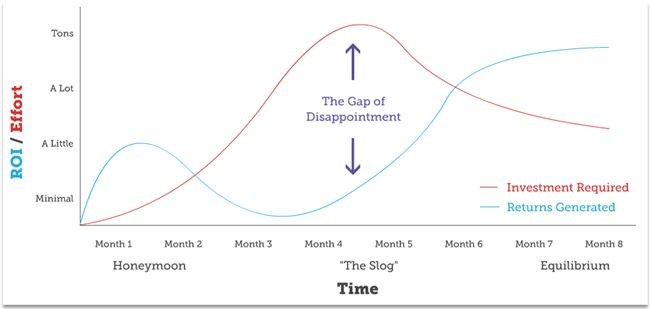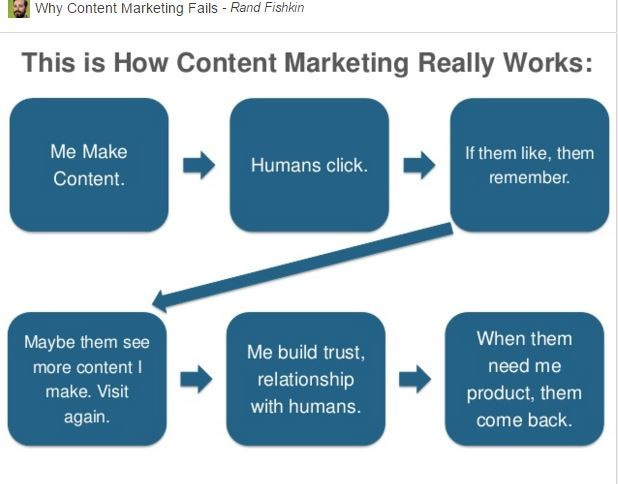Why Content Marketing Takes So Damn Long
Because trust isn’t built in a day — and neither is traffic, leads, or authority.
You’re doing the right things.
You’ve got a website. Maybe a blog. Maybe even a few social posts or an ebook out there.
And yet... the phone’s not ringing. The leads aren’t pouring in.
If you're wondering why your content marketing isn’t working — or at least not fast enough — you're not alone. Every SMB owner hits this wall. You know you need to be doing something different, but no one tells you just how much patience this game requires.
This isn’t about making excuses. It’s about explaining why content marketing takes time, why that time investment matters, and how to set realistic expectations from the start.
Let’s dig into the five big reasons content marketing moves slower than you want — but ends up delivering more than you expect.
You don’t have to take my word for it. Go to your favorite search engine and type in a variation of “why does content marketing take time” and you’ll find a deluge of articles that all basically say:
It’s a marathon, not a sprint.
That’s boring to hear. It’s boring to write. I’d prefer fast results for clients (and myself, for that matter!).
It’s hard to wait. You can order a book in the morning and be reading it that afternoon.
But you can’t have it all now. Sorry.
So Why’s It Take So Long?
Two things popped into my head as I started writing this:
“Patience” by Guns N Roses (what a GREAT rock album).
The movie Willy Wonka and the Chocolate Factory, with Veruca Salt whining, “But I want an Oompa Loompa NOW!!!”
Rather than throw statistics at you (though I’ve included a few), I’m sharing what I’ve seen firsthand working with content marketing clients.
You have to give content marketing time to work. And, no, you can’t have your leads NOW.
But with patience? You get better leads.
How much patience? Content marketing usually starts showing results in about 9 months. Sometimes sooner, sometimes later — but 9 months seems to be the sweet spot. That’s based on research and my own experience.
I’ll explain the five reasons in a second. First, I want to share two graphics from Rand Fishkin. He was CEO of Moz when I began using these. These graphics have held up for years because they explain why content marketing takes time — and effort.
Here’s the Trough of Disillusionment. It’s about SEO, but the lesson applies: early excitement gives way to frustration before long-term results kick in. Most companies give up in that dip. That’s when they should double down.
I’ve always loved this one; customers don’t move in straight lines. We create linear campaigns, but buyers zig-zag, bounce around, and take weird paths. This second graphic shows how we really buy things.
5 Reasons Content Marketing Takes Time
These aren’t just abstract concepts — I’ve seen each of these play out firsthand across different roles and industries. They’re the core reasons why content marketing takes time, and why it’s worth the wait.
1. Personas – Getting to Know Your Customer
Personas are fictional composites of your ideal customer, based on real interviews. Creating them takes time — scheduling and conducting interviews, analyzing the results, building a narrative.
They’re the foundation of everything. You need to know who you’re talking to, what they care about, what bugs them, and what gets their attention. Periodically reviewing them is also smart to keep things aligned with your audience.
Your persona work helps you earn the attention of the 57–70% of B2B buyers doing research before they ever talk to sales (source: Worldwide Business Research).
2. Your Site Traffic Is Horrible
Take an honest look. For many businesses — especially copier dealers — traffic stinks. Which means fewer chances to convert visitors into customers.
Even when raw stats look decent, I usually find:
A ton of traffic from existing customers logging in to portals
Decent home page traffic, but terrible rates (bounce rate is when someone comes to your site and leaves from that page without looking at any other pages on a website – high bounce rate is a bad thing).
Here’s the User Flow of a past copier dealer client at the very beginning of working with my former agency.
Notice that the traffic has a high rate of drop off and the rest are visiting meter reading and service and supply pages. No true prospects in that bunch.
If your site mostly attracts current customers, you’re essentially starting from scratch with new leads. And since 71% of B2B researchers start with generic Google searches (Konstruct Digital), you need content that ranks early in their journey.
3. Content Creation
A big pet peeve: the assumption that writing is easy.
It’s not.
I’ve written and edited for 30 years. I can write fast, but writing something fast and effective took decades of practice.
It takes time to:
Pick effective keywords
Analyze traffic and trends
Plan an editorial calendar
Research, write, edit, and format content
If you’re running a business, odds are you don’t have time to do all that well. Partner with someone who does.
According to HubSpot, companies that publish 16+ blog posts per month generate 4.5x more leads than those that publish four or fewer.
Quality matters. But quantity is also a quality.
4. Building Relationships – Not a One-Night Stand
Most marketing tries to jump straight to the sale — like skipping from a first drink to “let’s go back to my place.”
Sometimes that works. But not often.
Content marketing is about building trust. That takes . . . well, you know, time.
Gartner says 75% of B2B buyers prefer a rep-free experience. Your content is the relationship long before a salesperson shows up.
5. Distribution
Creating great content isn’t enough — you have to get it out there.
Google prioritizes useful, high-quality content in search. That takes time. And with AI and ad changes shaking up SEO, you also need to distribute through social media, newsletters, and email.
Direct access to a potential customer’s inbox is gold. Newsletters are one of the best ways to own that relationship.
Push your content out. Don’t wait for folks to find it.
Stop Waiting
Content marketing is a long-term strategy, not a short-term tactic.
For example, John Deere has been publishing The Furrow as part of their content marketing strategy since 1895.
It’s a strategy that accumulates and pays dividends over time. It compounds. I’ve had clients still generating leads from ebooks we published years ago. Blog posts that hit page one on Google and stayed there — with regular updates — for years.
That’s why content marketing delivers 3x the leads of paid ads or cold calls at 62% of the cost (Source: Content Marketing Institute).
Some of this might’ve sounded a little dire.
It’s not. I love this stuff!
But you need to go into content marketing with clear eyes. It’s a journey. You’ll hit roadblocks. You’ll take detours. Some will be amazing. Some frustrating.
You’ll need patience.
You can’t have your leads (or an Oompa Loompa) now — but every journey starts with a single step.
Start walking.
Grow your business with a newsletter, a cornerstone for any content marketing plan. Work with me, and we’ll do it together. Let’s talk. Even if we don’t end up working together, you’ll walk away with an idea or three you can use. Click here to schedule a 30-minute conversation.
Two obvious things I listened to while editing this post:
And, of course:





